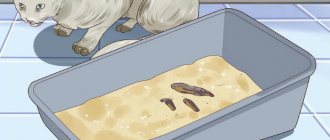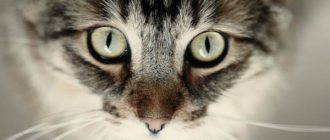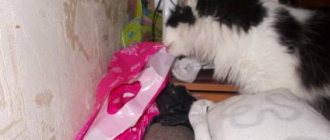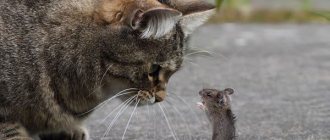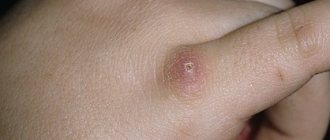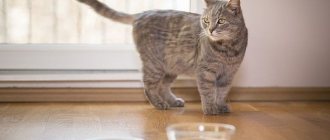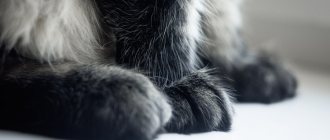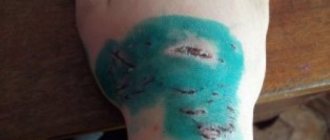It is known that cats are truly clean animals. It is natural for a cat to spend a lot of time grooming itself. A cat that bites its claws can look cute and touching. Sometimes this can be natural for the animal, since in this way the cat cleans its paw, making it clean. It happens that the claws are dirty, nothing more. But this behavior is not always natural for a pet. But not always, which also needs to be taken into account. In such cases, it would be a good idea for the owner to carefully examine the cat’s paws; there may be damage. Sometimes a cat will have to be weaned from this bad habit, just like a person. But first, you need to understand as accurately as possible why a cat bites its claws. Only in this way will it be possible to understand what can and should be done next.
The reasons why a cat bites its claws can be very different. Sometimes it is not a problem for the owner to cope on his own, but sometimes the pet will have to be taken to the veterinarian to help his beloved cat. Let's look at what reasons there may be when a cat bites its claws. Indeed, sometimes this can lead to negative consequences for the animal, even to the point that the cat injures its paw.
Why does a cat chew its claws?
Our mustachioed friends, cats, are very similar to ourselves, because they have some habits that are identical to humans.
One of them is the habit of biting its claws. However, when it comes to pets, they do this for a reason or out of boredom. A cat bites its claws due to certain problems or circumstances. So why do mustaches do this? There are 5 most common reasons for this :
- The pet has sore paws.
- The cat suffered significant stress for her.
- She lacks minerals.
- The mustachioed man is trying to get rid of his overly long claws.
- The animal has a fungal disease.
So, now let's look at each reason in more detail.
Symptomatic diet and procedures
To ensure that itching bothers your cat as little as possible, prevention is important. Experts recommend adhering to the following simple rules:
- The animal needs to be provided with healthy, balanced food. For these purposes, it is better to use specialized food.
- The cat should not be fed smoked meats, sausages, or junk food from the table.
- Regularly brush your cat, remove hair mats, and inspect the surface of the animal’s skin.
- Once every six months, treat the fur against parasites (relevant for animals that at least occasionally go out for a walk).
- Do not allow your cat to come into contact with street animals.
- Avoid situations in which your cat can taste or smell household chemicals.
- In case of insect bites, promptly treat the bitten area.
- Once a week, inspect your cat’s ears for mites and inflammation.
If a cat scratches and chews itself, this is not always bad. The desire to scratch is natural for animals. You should pay attention to your pet when scratching begins to interfere with a full life. Timely treatment will help your cat recover faster and prevent unpleasant complications associated with endless itching.
Stressful situations
One of the most common causes of nail biting is stress. Of course, if a cat walks on the street, then it can experience a lot of trouble there. But those cats that live in an apartment can also encounter many problems in their life. The reasons that cause stress in a cat are often :
- guests unknown to her;
- the appearance of a new family member - a small child, another cat or another animal;
- changing of the living place;
- new owner;
- traveling by public transport or car;
- visit to the veterinarian;
- taking medications, especially forced ones, or any other health procedures.
If an animal bites its claws precisely because of stress, then it is necessary to identify the cause and eliminate it. Having come out of a stressful state, the cat will stop gnawing on them.
When should you worry?
It's worth noting that you can't always tell when a cat is biting its claws. Your cat is not in sight 100% of the time. And some cats like a little privacy when grooming.
But if your otherwise healthy cat doesn't have proper nail care, she may resort to excessive chewing. Fixing this problem is not difficult - try a quality scratching post.
Beyond this simple solution, there are situations where nail biting is abnormal. This may be a sign of one or more medical conditions that require more urgent treatment. Excessive nail biting is usually associated with a medical or behavioral problem. So let's look at a few common problems and possible solutions to fix them.
Big claws
Cats also chew their claws for a very simple reason: when they grow too big. This problem is especially acute for domestic cats who do not leave the apartment, since animals that walk on the street wear down their claws naturally. To solve this problem, you need to force your pet to lead an active lifestyle and play with it more often . You should also purchase a scratching post for your cat, on which he can sharpen his claws.
Another old and effective method to get rid of this problem is to regularly trim your pet’s nails. However, not many people manage to do it correctly, which is why a lot of other problems often arise due to sloppy haircuts. You can also avoid this kind of trouble by using special silicone caps, which have many advantages. With them:
- no need to cut the cat's claws;
- you can forget about scratching posts and scratched furniture;
- give your pet a very glamorous look, since multi-colored silicone attachments look very unusual on the paws of a mustachioed one.
Fungal diseases
And finally, the last and very dangerous reason is a fungal infection. This disease is easy to detect because it often appears on the claws of the front paws. Taking a closer look at your pet's claws, you will be able to see their deformation, peeling, clouding and peeling. In advanced cases, the claw may even die. In addition, it should be remembered that a sick pet can become a source of infection for other animals or people. Therefore, you should definitely use the help of a specialist and follow all veterinary instructions.
In general, if you notice that your cat is biting its nails, you should not push this problem into the background. The sooner you deal with it, the easier it will be for you to avoid further troubles related to your pet’s health.
What to do?
If the case is advanced, the claw has grown into the finger, the pad of the finger is swollen, or the animal is in pain, the surest option is to contact a veterinary clinic to avoid complications. In such cases, surgery is indicated - the finger is opened and the claw is removed. Do not try to treat your pet yourself if your finger is inflamed and festered! This is fraught with blood poisoning and associated dangerous complications. The operation is not complicated, but it is better not to allow this to happen.
If it happened like it did for me, namely, the claw grew to the finger, slightly ate into it, but did not grow in, the finger does not hurt, the cat does not complain, you can try to deal with the problem yourself.
For this you will need:
- Antiseptic agents - napkins or just cotton wool and any disinfectant - alcohol, vodka, hydrogen peroxide, etc. What you will find in your home medicine cabinet.
- Scissors for trimming animal claws. I recommend that all cat owners have special scissors, since ordinary nail scissors are not suitable for a cat's claw - cutting with them can lead to cracking of the claw.
- If your cat is very restless, you can give him a natural cat sedative. I usually get by without it.
This is how pieces of the claw peeled off. So:
Fix the cat’s paw and sit him down so that the animal does not get nervous or twitch again. Treat your claw and finger with antiseptic just in case. Trim the claw carefully. When trimming, make sure the end of the claw extends freely from the pad of the toe.
If this does not happen, the depth of ingrowth is minimal, slightly pull the claw away from your finger. If it doesn't come out, don't try to pull it out. Grasp the claw with scissors at a distance of about 2-3 mm from the tip and trim it. If the claw is layered and large, trimming can take place in several stages. Cut the claw confidently, but not with all your might (to avoid cracks and injury). In my case, with the first effort, two layers of dead claw came off, and it became thinner. With the second press, another layer came off and the third time it was possible to cut off the first 3 mm. If in your case the claw is still ingrown, after separating it from the pad, try to carefully remove the ingrown piece with tweezers. If you correctly determine that the claw is not deeply embedded, everything should work out. If blood appears, treat your finger with a pre-prepared antiseptic.
That's not all. Since the claw is long, you need to trim it to the end. However, do not overdo it - the fact is that if the claw has not peeled off, it becomes opaque and the vessels are not visible through it. Don’t overdo it, it’s better to cut a little more and gradually remove the remaining length with a regular manicure file. And now that's it.
Injury to the claw, pad or toe
First of all, the owner needs to note whether the cat bites the claws on all paws indiscriminately or prefers the same one. If a pet persistently licks and bites a strictly defined limb, then you should carefully examine the fingers, claws and pads on it for:
- scratches, sores and cuts;
- inflammation of the interdigital membrane;
- stuck splinters, plant thorns, glass fragments and pieces of wire;
- broken and cracked claws;
- inflammation of the claw bed.
What to do. In simple cases, it is enough to treat the paw with an antiseptic solution (hydrogen peroxide, Chlorhexidine, Miramistin) and repeat the manipulation for several days until the wound is completely healed. Removal of foreign bodies and inflammation of the nail bed requires the assistance of a veterinarian.
Self-soothing remedy
Just like humans, cats can bite their claws when stressed.
The monotonous movements of the jaws are similar to the sucking reflex, which at a tender age guaranteed food and safety in the native nest next to the mother. This is why emotional and sensitive cats, having experienced trouble, put their paws in their mouths and do not take them out for a long time.
The psyche of apartment pets, kept in relative isolation and unfamiliar with a variety of stimuli, is especially fragile. Thus, an animal can experience severe stress due to:
- appearance of strangers;
- ongoing repairs;
- change of owner and place of residence;
- transportation;
- a visit to the veterinarian or to an exhibition;
- bathing and hygiene measures;
- injections and other medical procedures.
By analyzing recent events, you can identify the stress factor and become convinced of the psychological nature of the “bad habit.” As soon as the negative event is forgotten, the cat will stop gnawing its claws and calm down.
Instructions for action
If a cat begins to bite its claws, then it is worth examining them. If the cat's claws are in order, then the problem may be psychological discomfort or a lack of vitamins and minerals. If you suspect a fungus or other disease, you should consult a veterinarian. The easiest way to contact a specialist is to contact him through the application from the website. Here you can make an appointment at the veterinary clinic.
Download the specialized application for pet owners Petstory on the IOS and Android platforms using the link – https:///prilozhenie-konsultacija-veterinar/.
Lack of minerals
The desire to bite claws may be due to a lack of minerals in the body or their imbalance. Unable to find a more suitable source, the cat gnaws on mineralized parts of its own body. A similar condition is noted:
- with a poor, monotonous diet;
- during a period of intensive growth;
- during pregnancy and breastfeeding;
- after injuries during fracture healing;
- in case of poor calcium absorption and hormonal diseases.
Associated symptoms. An additional symptom of a lack of mineral nutrition is the instinctive need to lick, chew and swallow:
What should the owner do? To correct the situation, it is necessary to transfer the animal to a nutritious diet, using premium and super-premium food, and with natural feeding, provide high-quality vitamin and mineral premixes.
Poor nutrition and diseases
Like people, cats can chew their claws on their front and hind paws when their diet lacks minerals and vitamins. This is a signal for the owner that it is time to reconsider the diet and add a vitamin and mineral complex to the diet. However, the reason may not be diet - cats bite their claws due to fungal diseases and allergies.
If the cause has not been established, it is recommended to talk to a veterinarian - it will be easier for a specialist to find and eliminate it. It is difficult for the owner to distinguish fungal diseases from injuries that the cat received on the street or at home. Many owners do not pay attention to such little things as the condition of their pet’s claws, and discover the problem already in an advanced stage. If there are no veterinary clinics nearby, you can still find a way out of the situation.
In a situation where a cat eats from the owner's table, it almost certainly does not receive vitamins. It is impossible to take into account all the nuances of a cat's diet; it is easier to choose the right food. With a balanced diet, the problem is most likely a disease.
Fungal infections in cats are the most dangerous. They last for a long time and cause a lot of problems. Moreover, the owner and members of his family can become infected from the cat, because the fungus is transmitted. It can be identified visually - it affects the nails in patches, creating cloudy areas that peel and crumble.
Fungal infections of claws
A fungal infection affects not only the skin and mucous membranes, but also the hairs and claws of animals. The claws of the front paws are especially affected, becoming:
- thickened and deformed;
- flaky and cloudy;
- crumbling and chipping.
In the severe stage of the disease, the crumpled claw dies.
How to help your pet. It should be remembered that fungal infections are very contagious, so a sick pet poses a danger to both its relatives and the owners themselves. That is why, in case of any suspicious behavior, you should show the cat to a veterinarian and undergo laboratory tests.
If everything is in order with the health of the mustachioed tabby, but the habit of biting its claws is too ingrained, then you can use colored silicone caps from the pet store. They are securely fixed on each claw with glue, giving the pet a glamorous look and weaning it from bad habits.
Why does a cat bite its claws: physiological or psychological problems. How to help your pet?
How often do you see your cat sitting proudly on a cross, with her toes spread and her teeth diligently polishing her claws? The pet clamps each claw with its front incisors and cleans it with a characteristic clicking sound. Some owners are worried why a cat chews its claws, while others are puzzled by the fact that their pet does not pay attention to its manicure. Let's look at what's normal and when to worry.
Causes
Quite rarely, but it happens that a cat bites its claws for no particular reason. By analogy with the “bad habit” of a person who bites his nails since childhood, out of boredom or excitement. In this case, the line between “normal” and “abnormal” behavior is very thin, since the process leads to complacency. In fact, how normal the chewer’s condition can be judged only by the depth of stress, and not by the length of the nails or the frequency of strange desires that arise.
Note! Some decorative breeds of cats have weak, thin claws. They rarely worry about sharpening and cleaning their claws and this is normal. In outbred cats, which have a highly developed hunting instinct, a lack of interest in claws may indicate an anxious state.
When a cat is bored or lonely, the situation may not be limited to biting its claws. Loneliness is a great stress for a domesticated animal, and if the owner does not find time for the pet for a long time, the cat feels abandoned. Against the background of an obsessive anxiety state, a pet can pull out tufts of hair, lick its limbs or comb its body until it bleeds , and surprise the owner with sharply negative actions.
Note! Active cats with a “cult of the owner” suffer from obsessive neuroses much more often.
Having studied the works of animal psychologists, we can conclude that biting claws may have causes related to:
- Personal hygiene – most often.
- Illness.
- Behavioral motives, stress, compulsive disorder - least often.
The main reasons why cats crush people with their paws, and the owner’s actions in case of such behavior
Affectionate furry pets have long gained the reputation of being one of the most mysterious and amazing creatures among domesticated animals. Cat breeders often note such a feature of their pet as the so-called “milk step”. Seeing these unusual movements, many people wonder why cats crush people with their paws.
Animal psychologists have several hypotheses about this peculiar ritual. A cat lover will be interested in finding an explanation for the unusual behavior of his affectionate couch potato.
Read in this article
Behavioral motives
A cat may chew its claws if they are not well-groomed. Make sure that the scratching post is in the pet’s constant access; if necessary, update the accessory. Don't forget to inspect your pet's claws once every 1-2 weeks. Claws that are too long and curved need to be shortened with a guillotine nail clipper or nail file.
Pets that walk outside should have their paws examined every day. If your cat appears anxious, make sure that:
- breaks or cracks on the claws - in the case of cracks, the condition should be monitored and, if possible, the claw should be trimmed (if the crack does not touch the blood vessels). If blood oozes from the injured nail or it interferes with the animal's ability to walk, we recommend contacting a veterinarian. By cutting a claw while it's alive, you will cause your pet a lot of pain and cause heavy bleeding. Without care and initial treatment, a short-cut claw is an open wound, which is fraught with infection.
- The pet has not injured a finger or paw - lameness, pain, attempts to bite its own paw and other behavioral oddities may indicate a sprained or torn ligament, fracture or other injury.
- Foreign object – while playing or walking, a cat can get a splinter that gets stuck under the skin. In winter weather, snow gets stuck between the cat's toes, which quickly turns into ice. The difficulty is that the ice causes great discomfort, and if these mini-snowballs contain salt and sand (which is sprinkled on footpaths), they also bake a lot. If a cat does not gnaw out the snow stuck between its toes in time, it risks chemical burns and frostbite.
In a state of severe stress, a cat tends to calm itself by licking. The process emits stroking and stimulates the nerve endings of the hair follicles. In response to licking, the cat's body produces endorphin. A cat that is stressed for a long time may lick areas of its limbs to the point of open wounds. The disease is called lick granuloma.
Note! A licked granuloma is not an injury, but the consequences of a psychological disorder. Treatment involves a complex of procedures: the affected areas are treated, the condition is treated symptomatically with the obligatory use of sedatives.
When the phenomenon is observed
The owner most often observes the peculiar behavior of a domestic cat when the animal is in a peaceful and calm state. At this moment, the pet may purr. Some cats perform the ritual without releasing their claws. Other individuals can crush the soft surface, extending their claws to their full length. At the same time, the animal looks concentrated, the reaction to external stimuli becomes minimal. Some owners compare this state of their pet to nirvana.
Many cat breeders note that the cat ritual usually takes place on a soft and pliable surface: a blanket, a mattress, the owner’s lap. A hard surface is not suitable for such purposes. Often the “milk step” is used in relation to a soft toy.
Most often, a cat crushes a soft object with its paws when it is about to rest or sleep. Expectant mothers begin to prepare the nest for childbirth and offspring, often before an important event they begin to knead the blanket with their paws. Pets love to perform such a mysterious action when they are on the lap of their beloved owner. Fans of cats note that a cat performs such a ritual only with its owner; such affection is not available to a stranger.
To learn about what a “milk step” is in cats, watch this video:


